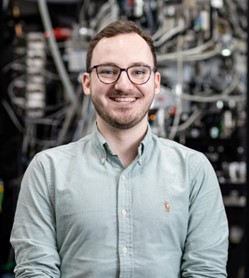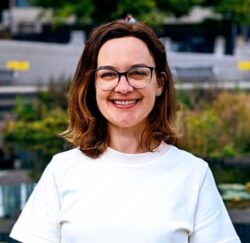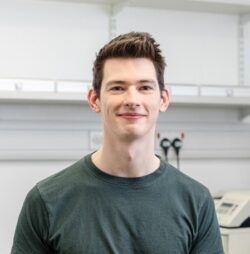Meet the trainers
Dr Oksana Degtjarik – Cryo-EM Scientist, ABSL EM Facility, University of Leeds
At our facility, I tackle various single particle cryo-EM projects covering the entire workflow – from initial sample preparation to 3D map reconstruction and model building. I have a strong affinity for challenging membrane proteins, with GPCRs being my personal favourites due to their complexity and pivotal role.
Additionally, I enjoy training new users, with the aim of making the cryo-EM technique more accessible to researchers.
Dr Louie Aspinall – Electron Microscopy Facility Manager, ABSL EM Facility, University of Leeds
I am responsible for the day-to-day operation of the facility, ensuring that we continue to provide the high-quality services that we’re known for. My main interests are in sample preparation for cryo-EM, including TEM grid technology and air-water interface interactions. Lately, I have been largely involved in time-resolved cryo-EM studies that help us to understand protein dynamics whilst also providing a fun challenge.
Dr Yehuda Halfon – Cryo-EM Scientist, ABSL EM Facility, University of Leeds
I am responsible for the day-to-day operation of our two Titan Krios electron microscopes and training the users on how to screen and collect data of their samples. I enjoy doing more Tomography things than Single Particle Analysis, mainly working on hard samples that require more playing with the settings of the microscope in order to get the best results.
Dr Tom O’Sullivan – Correlative Imaging Scientist, ABSL EM Facility, University of Leeds
I manage cryogenic correlative light and electric microscopy (CLEM) workflows at the University of Leeds EM facility. Whilst my background is in fluorescence microscopy techniques (SIM, lattice, SPIM), over the last couple of years I’ve enjoyed developing techniques to prepare cryogenic tissues and cells for electron tomography. Specifically, I enjoy optimising vitrification, and thinning of tissues and cells for the preservation of in-situ structures.
 Dr Joshua White – Cryo-EM Scientist, ABSL EM Facility, University of Leeds
Dr Joshua White – Cryo-EM Scientist, ABSL EM Facility, University of Leeds
My current role focuses on working with industry projects that come through our facility. However, I’m always excited to see projects from our academic users and help them to get the most out of their data. My favourite projects involve investigating the conformational landscapes of membrane proteins.
Dr Emma Hesketh - Cryo-EM facility manager at the University of Leicester
I manage the Cryo-EM facility at the University of Leicester (LISCB) which is part of the Midlands Regional Cryo-EM consortium including the Universities of Birmingham, Warwick and Nottingham. We house a Titan Krios G3 equipped with a Gatan K3/BioQuantum and a dedicated freezing laboratory. As Cryo-EM Facility Manager I oversee day-to-day running of the Cryo-EM facility including training users, troubleshooting experiments, and assisting external users. I love troubleshooting grid preparation issues and analysing data. My favourite samples are viruses.
The Cryo-EM facilities at Leicester are available for external users please go to www.leicester.ac.uk/cryoem to find out more.
Dr Daniel K. Clarke - Principal EM Scientist at eBIC and Diamond
I am currently one of the principal EM scientists at eBIC and co-manage a large international user program on the microscopes at Diamond light source. I have been doing cryo-EM for a while now… I started with poorly-ordered membrane protein 2D-crystals and from there graduated to large ‘soluble’ molecular chaperones. Most of my experience in cryo-EM was gained at Birkbeck College, and I was the student that never left. In my latter years at Birkbeck I took on the role of training new users on the Polara microscope and was also heavily involved in the selection and commissioning of the new direct electron detectors they acquired. I have also been involved with all of the EMBO image processing course run at Birkbeck and have either given a talk or helped with the practical sessions. I look forward to meeting you on one of the courses soon.
Dr Natasha Lukoyanova - EM Facility Coordinator, Birkbeck College, University of London.
I manage the ISMB Birkbeck EM facility in London. We provide training, access to EM equipment and services for structural biologists from UCL and Birkbeck. I am interested in the optimisation of EM sample preparation and data collection, with cellular samples being my personal favourite.
Dr James Streetley - SCMI Facility Manager, Scottish Centre for Macromolecular Imaging, University of Glasgow
I manage the Scottish Centre for Macromolecular Imaging, a cryo-EM facility based at the University of Glasgow but formed by partners in the Universities of Edinburgh, Dundee and St Andrews, and open to the wider Scottish structural biology community. My favourite thing to image is the thin edge of the cell; it’s like looking at a cell biology textbook, pointing out the mitochondria, ribosomes, actin, microtubules. It’s hard to keep focussed on the object of interest and not get carried away by everything thing else.
Otherwise, I enjoy all kinds of problem solving, be it fault finding with engineers or working out how to implement the latest techniques on our machines for our users to start experimenting with.
Staff profile: https://www.gla.ac.uk/researchinstitutes/iii/staff/jamesstreetley/#
Facility site: https://www.gla.ac.uk/researchinstitutes/iii/cvr/facilities/scmi/
Dr Lorna Malone - Cryo-EM Scientise, Diamond Light Source
I am currently one of the cryo-EM scientists at eBIC (Diamond Light Source) providing day-to-day operational support for SPA and cryo-ET users of our four Titan Krios electron microscopes, Glacios and Talos. In addition to this role, I also develop & coordinate training courses for our user community and collaborate with other groups to develop events, workshops & conferences to benefit the cryo-EM community.
My research experience is mostly in single particle analysis of large photosynthetic membrane protein complexes which I undertook at the University of Sheffield however since starting at eBIC I have been heavily involved with the Chameleon user programme and have helped to optimise sample preparation for numerous different types of tricky samples.









